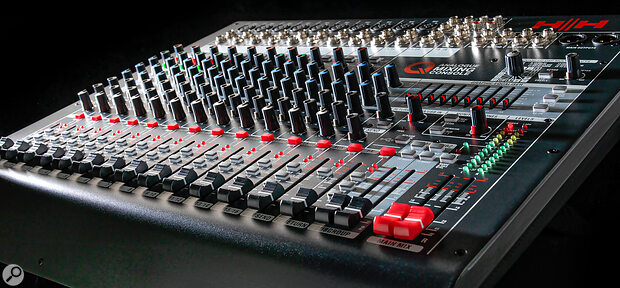Digital mixing might be all the rage, but sometimes a simple analogue desk is exactly what you need.
While we now have a variety of digital mixers from which to choose, many with quite different modes of operation, there’s something reassuring about a conventional, knob‑laden analogue desk that you can pick up and use straight away with barely a glance at the operation manual. The HH Q16FX is exactly such a product, offering all the essentials for hands‑on mixing. It is solidly built in a metal case with a lifting handle inset into the left‑hand side, and has direct mains power (100‑240 Volts) rather than an annoying external PSU. Practical colour coding is used for the control knob caps to aid navigation.
If you’re not familiar with the HH name, the original company launched some of the first solid‑state guitar amps and PA systems, their most distinctive feature being their electro-luminescent front panels. Today the name belongs to UK brand Headstock. Designed in the UK and then built ‘off shore’, the HH Q16FX is one of a range of Q‑series analogue mixers offering between six and 16 channels, dependant upon the model you choose. These seem to be designed primarily for live‑sound applications, though they also function as 2‑in/2‑out 24‑bit USB audio interfaces running at 48kHz.
In the Q16FX, the 16 channels are deployed as eight mono mic/line channels, two stereo line‑only channels and two stereo/mono mic/line channels. Channels 1‑8 include a single‑knob compressor, and every channel has a three‑band EQ operating at 12kHz, 2.5kHz and 80Hz. The mono channels have a useful separate 75Hz low‑cut filter too. Onboard DSP effects are included, with a choice of 16 effect types based around the mainstays of reverb, delay and echo. A nine‑band graphic EQ is available to process the main or monitor mix, and this includes a feedback detection feature so you know which band is causing the problem.
Channels can be routed to the man output and/or to a pair of subgroups — useful if you want to control the whole drum mix using a single fader. There’s a single pre‑fader aux send per channel for setting up a monitor mix, and there’s also a post‑fader send for the internal effects, but with the option to also send that signal to an external effects unit. The mono mic inputs and main mix outputs are on balanced XLRs, with all the other connections being quarter‑inch jacks, other than the inputs for the USB/phono channel (which are on RCA phono sockets and USB‑B).
Channel...
You are reading one of the locked Subscribers-only articles from our latest 5 issues.
You've read 30% of this article for FREE, so to continue reading...
- ✅ Log in - if you have a Digital Subscription you bought from SoundOnSound.com
- ⬇️ Buy & Download this Single Article in PDF format £0.83 GBP$1.49 USD
For less than the price of a coffee, buy now and immediately download to your computer, tablet or mobile. - ⬇️ ⬇️ ⬇️ Buy & Download the FULL ISSUE PDF
Our 'full SOS magazine' for smartphone/tablet/computer. More info... - 📲 Buy a DIGITAL subscription (or 📖 📲 Print + Digital sub)
Instantly unlock ALL Premium web articles! We often release online-only content.
Visit our ShopStore.

